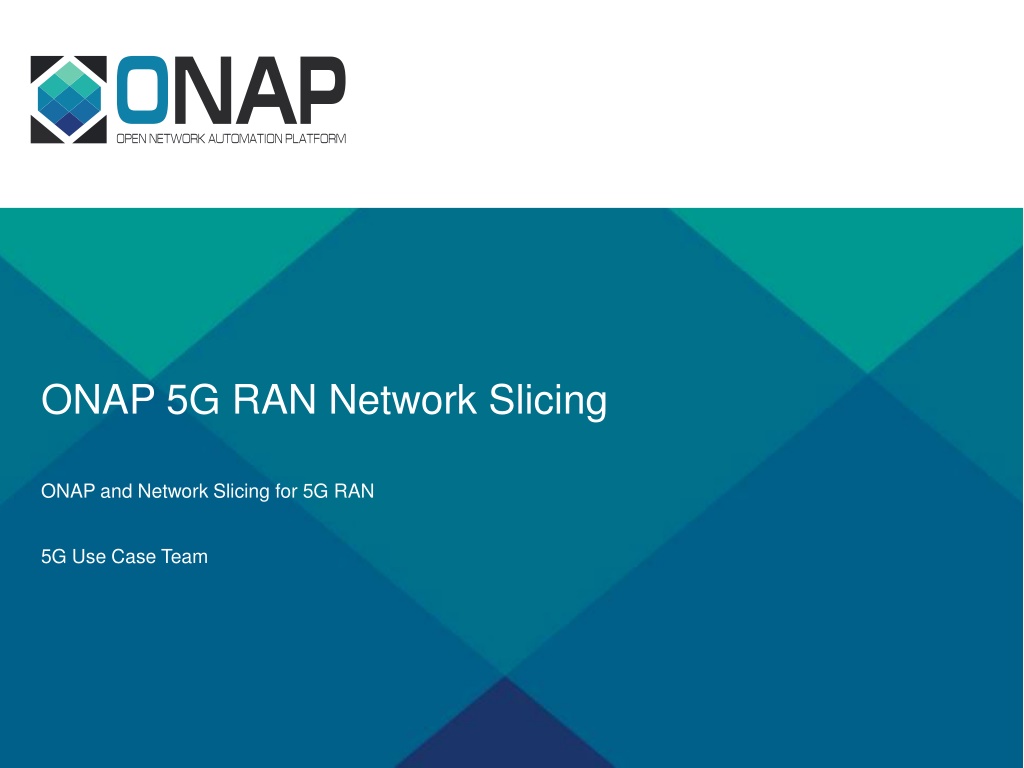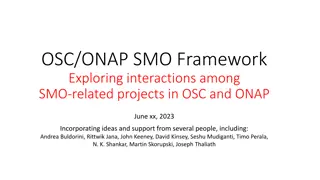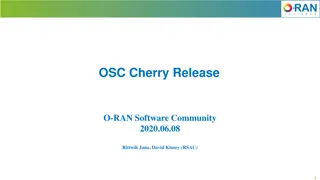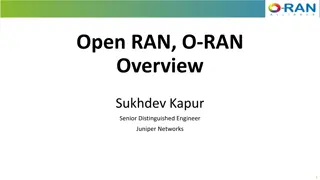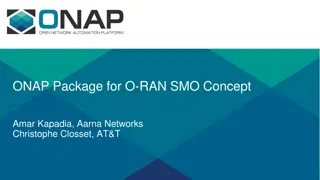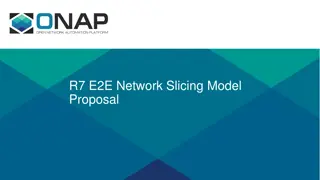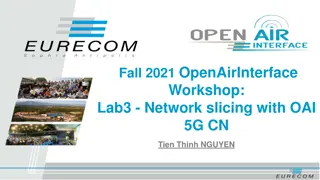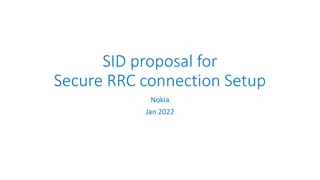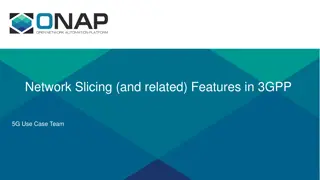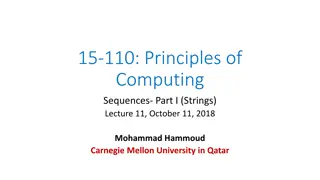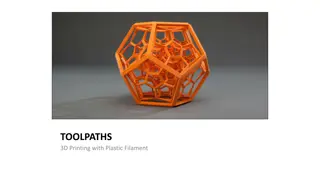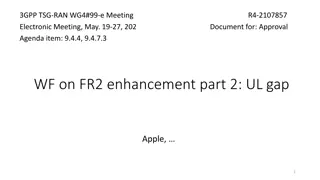Understanding 5G RAN Network Slicing and Architecture
Explore the intricate world of 5G Radio Access Network (RAN) and Network Slicing, delving into concepts such as SO Service Orchestrator, SDN-C Service Design, and Core Network Elements. Discover the significance of managing and designing mobile slice services, including eMBB, Massive IoT, and Mission-critical IoT. Unravel the complexities of 5G RAN Architecture and Configuration, along with instantiating slices on CU/DU elements for enhanced network performance.
Uploaded on Aug 02, 2024 | 0 Views
Download Presentation

Please find below an Image/Link to download the presentation.
The content on the website is provided AS IS for your information and personal use only. It may not be sold, licensed, or shared on other websites without obtaining consent from the author. Download presentation by click this link. If you encounter any issues during the download, it is possible that the publisher has removed the file from their server.
E N D
Presentation Transcript
ONAP 5G RAN Network Slicing ONAP and Network Slicing for 5G RAN 5G Use Case Team
5G Radio Access 5G Radio Access Network Architecture Network Architecture SO Service Orchestrator SDN-C Service Design Network Controller DCA&E Data Collection Analytics & Events A&AI Available & Active Inventory APP-C Application Control ONAP Run Time Management OSS BSS SO SDN-C DCAE APP-C A&AI 5G Core Network Elements RAN Network Elements Application Ecosystem Disaggregated Core CU-CP-H UPF SMF UDM AUSF Antenna 5G Base Station CU-CP-L Back Haul Internet Centralized Cloud Edge Cloud RU DU CU-UP Front Haul External Content Mid Haul UE UPF User Plane Function SMF Session Management Function UDM Unified Data Management Function AUSF Authentication Service Function RU Remote Radio Unit DU Distributed Unit (5G Base Unit) CU-UP Centralized User Plane CU-CP Centralized Control Plane (low and high)
5G Network Slice 5G Network Slice Network Architecture Network Architecture ONAP ONAP Management - Design Management - Runtime Mobile Slice Services (e.g. eMBB, Massive IoT, Mission-critical IoT) E2E Slice Instances (NSIs) Core Slice Segments (NSSIs) RAN Network Slice Segment (NSSIs) Transport Slice Segments (NSSIs) RAN Abstraction Model Transport Abstraction Model Core Abstraction Model 5G Core Network Elements RAN Network Elements Application Ecosystem Disaggregated Core CU-CP-H UPF SMF UDM AUSF Antenna 5G Base Station CU-CP-L Back Haul Internet Centralized Cloud Edge Cloud RU DU CU-UP External Content Mid Haul Front Haul UE
5G Network Slice 5G Network Slice Network Architecture Network Architecture
5G RAN Architecture 5G RAN Architecture RAN Network Elements 5G Base Station DU #1 Cell #1 Tracking Area Cell #2 RU #1 Registration Area Edge Cloud RU #2 DU #2 CU Cell #n Tracking Area RU #n DU #n
5G RAN Configuration 5G RAN Configuration RAN Network Elements 5G Configuration Instantiating a Slice on a CU/DU You could send an activation command To active a service (e.g. Video streaming) w/ Parameters pre-provisioned. Base Station DU #1 RU #1 Services can be on demand Slices are defined in the CU RU #2 DU #2 CU RU #n DU #n
5G RAN Architecture 5G RAN Architecture A Cell is a Sector Frequency Beta Alpha An antenna stacked dipole Which can Shape the Radio frequency Energy Alpha Sector & f1 = Cell #1 Alpha Sector & f2 = Cell #2 Alpha Sector & f3 = Cell #3 Beta Sector & f1 = Cell #4 Gamma Sector & f1 = Cell #5 Gamma
Registration Area & Tracking Area Configurations Registration Area & Tracking Area Configurations The Registration Area may have any Number of Tracking Areas 1 1 Cell #1 Tracking Area And Tracking Areas may have any number of Cells. Cell #2 Tracking Area Registration Area Cell #3 Tracking Area 4 4 Multi-Carrier Cell, f1-f2-f3 in same sector are in the same Tracking Area Cell #1 Cell #4 Tracking Area Tracking Area Cell #2 Cell #5 Tracking Area Cells might be serviced by different DUs Registration Area Cell #n 2 2 3 3 Cell #1 Tracking Area Cell #1 f1 Alpha Sector Cell #2 Cell #2 f2 Alpha Sector Tracking Area Cell #3 Tracking Area Cell #3 f3 Alpha Sector Cell #4 Registration Area Cell #5 Cell #4 Tracking Area Registration Area
UE in a Tracking Area UE in a Tracking Area UE & TRACKING AREAS A Mobile (UE) is in one Tracking Area (TA) A UE is in one Registration Area A UE is in one Cell UE can support up to 8 slices (simultaneously) Cell #1 PHYSICAL A UE is physically in a geographical location That geographical location is served by a RU/DU That is, physical RF resources (RF waves) Tracking Area #1 Cell #2 RU #1 Registration Area LOGICAL A UE is in a logical Cell And simultaneously a UE is in a logical Tracking Area Tracking Areas comprise a Registration Area And thus a UE is simultaneously in a Cell, Tracking Area and Registration Area Cell #n Tracking Area #2
A Cell has only one Tracking Area A Cell has only one Tracking Area Per PLMN, there is a one-to-one correspondence between a Cell and a Tracking Area Code. Cell has one Tracking Area i.e. You cannot assign more than one Tracking Area Code to a Cell. Cell has a parameter (Tracking Area ID = TAI) TAI = PLMNID + Tracking Area Code (TAC) Cell #1 In multi-operator cell can have 6xPLMN IDs, but Every cell has a Primary PLMN. Thus there is still just one TAI. A UE subscribes to one PLMN only (thus a cell belongs to exactly one TA) Tracking Area Code Note: 3GPP36.300 section 10.1.7: If the E-UTRAN is shared by multiple operators, the system information broadcasted in each shared cell contains the PLMN-id of each operator (up to 6) and a single tracking area code (TAC) valid within all the PLMNs sharing the radio access network resources.
5G Network Slices (Example) 5G Network Slices (Example)
Slice Groups Slice Groups VERTICAL SLICES (examples): -Hospitals, -Companies, -Airports -Stadium -University Campus -Disaster Area or Security forces -Regional Trials -High Density Urban Community -Railway HORIZONTAL SLICES (examples): Wireless Broadband Real-Time Control IoT & Sensors Video Streaming VERTICAL SLICE HORIZONTAL SLICE FACTORY #1 Wireless Broadband Cell #1 Real-Time Control Cell #2 Tracking Area #1 5G AVANTAGE OVER 4G: End to End Accounting Built in to 5G framework (report, verify, account) FUNCTIONALLY: NSSP configures device. NSSP Maps applications to Slices A valid slice over multiple RegAreas would have Valid NSSAIs in multiple RegAreas IoT Sensors Registration Area #1 Video Streaming
Slice within a Tracking Area Slice within a Tracking Area OPERATION: - A slice must be consistent throughout a Tracking Area (e.g. the Real-Time Control Slice is the same for the UE throughout the Tracking Area #1) - A slice must be consistent for all of the Cells that comprise a Tracking Area. - Slices are only valid within the PLMN. - NSSAI (Network Slice Selection Assistance Information) are PLMN specific - Two PLMNs have NSSAI independent of each other. Cell #1 Real-Time Control Slice REGISTRATION AREAS: - Registration Areas are tied to NSSAI - UE registers with AMF (which provides the UE with the TAI and thus the registration area it is in) - Note: Cells don t announce slices - If you stay within the Registration Area the NSSAI is valid. Cell #2 Real-Time Control Slice Tracking Area #1 CONFIGURATION - Core control is done in CU, CallP is in CU. - Race condition of CU provisioning - Slice supported in a TA List - Configuration, Activation/Operation Registration Area #1 PLMN
Isolation between Slices Isolation between Slices OPERATION: - Factory #1, #2 each with their own Tracking Area - Typically, two different Factories (vertical slices) will have different horizontal slices tailored to that vertical slice. So there is typically isolation between slices. FACTORY #2 FACTORY #1 Cross Breeding : - If isolation is not desired, you can define the same slices between the two tracking areas. For example if Cell #1, #3 with same Slices accomplished by defining the same slices. Cell #3 Cell #1 Cell #4 Cell #2 Tracking Area #2 Tracking Area #1 Registration Area #2 Registration Area #1
Similar services (slices) over a large area Similar services (slices) over a large area OPERATION: - Services for slices of the same type over a number of cells/tracking areas Services made available in two different areas. - Core serves a list of Tracking Areas. - A registration area = a List of Tracking Areas - A slice is available in TA - A cell is exactly on TA - Core network functions must be instantiated on a set of Tracking Areas. - - Cell #3 Cell #1 Cell #4 Cell #2 Tracking Area #2 Tracking Area #1 Registration Area #2 Registration Area #1
Core Network functions on a set of TAs Core Network functions on a set of TAs OPERATION: - Core network functions must be instantiated on a set of Tracking Areas. - Core tells RAN elements which slices are supported - OAM puts cells in Tracking Areas, Connect CUs to the Core Network Elements that correspond to the TAs that the cells are in. - Define Cells, group into TAs; DU, CUs. - - - Core Network Elements Disaggregated Core UPF SMF UDM AUSF Back Haul Internet Centralized Cloud External Content Tracking Area #1 Tracking Area #2 Tracking Area #3 Tracking Area #4 Tracking Area #5 Tracking Area #n
Customized Horizontal & Vertical Slices Customized Horizontal & Vertical Slices VERTICAL SLICE Factory #1 Factory #2 Factory #2 s Wireless Broadband Slice Customizations of the general Wireless broadband slice. Is hosting a general assembly meeting and wants more dedicated wireless broadband usage. Factory #1 s Wireless Broadband Slice Customizations of the general Wireless broadband slice. Customized for particular monitoring Wireless Broadband Factory #2 s Real-Time Control Slice Customizations of the general Wireless Real-Time Control slice. Is testing a trial prototype proof of concept vehicular control platform. Factory #1 s Real-Time Control Slice Customizations of the general Wireless Real-Time Control slice. Installed with specialized factory vehicular controls HORIZONTAL SLICE Real-Time Control Factory #2 s IoT Slice Customizations of the general Wireless IoT slice. Has recently installed IoT sensors in their HVAC systems. Factory #1 s IoT Slice Customizations of the general Wireless IoT slice. Security Sensors tailored to the unique location of the Factory. IoT Sensors Factory #2 s Video Streaming Slice Customizations of the general Wireless Video Streaming slice. Is currently setting up a video streaming slice for their CEO to give a presentation. Factory #1 s Video Streaming Slice Customizations of the general Wireless Video Streaming slice. Currently is using a training video to all employees. Video Streaming
UE moves to new Tracking Area UE moves to new Tracking Area UE MOVES FROM CELL #3 to CELL #6: AMF provides TAI List (registration area) AMF > UE TAI List Cell #3 (with TA #1, #2) UE moves from Cell #3 to Cell #6 UE moves to a new Registration Area Cell #6 broadcasts its TAI List UE may get different slice support UE may initiate a registration procedure (PDU session slice ID registration procedure to get a slice ID) Cell #1 Cell #4 Cell #2 Cell #5 Tracking Area #1 Tracking Area #3 FACTS: IE (Info Element) list of TAI Reg-Area is all of the TAs in the TAI List. A Reg Area doesn t have a ID itself Cell #3 Cell #6 Tracking Area #2 Tracking Area #4 SERVICES: UE sees if that same service it still available on the new TA, based on SLA. If we desire the same service should have the same identifier. Moving to a new TA though you may not (as well). Registration Area #1 Registration Area #2 Tracking Area ID List (TAI) has Tracking Area #1, #2 TAI Updated. New TAI list has Tracking Area #3, #4
Slicing Costs Slicing Costs Slice Costs There are costs (OPEX, CAPEX) associated with Slices TOPIC TOPIC DESCRIPTION DESCRIPTION Cell #1 Counters / KPIs Performance measurements & monitoring of slices Defining parameters for operation of slices and RA/TA Configuration Network usage and corporate communication Maintenance of slices and cataloging slices & SLAs Tracking Area Cell #2 Definition, Network Provisioning Network Standardization Instantiating Slices Registration Area Cell #n Tracking Area 4G & 5G TA sharing/or not sharing a PLMN (from design)
3GPP TS23.501 Standards 3GPP TS23.501 Standards
Slicing & Network Sharing Slicing & Network Sharing CONCEPTS: - Slicing is independent of Network Sharing - Slice is only valid in one PLMN Network Sharing is between PLMN - One or more Cells may also belong to multiple PLMN Networks. - PLMNs in the same geographical area could each have a set of registration areas. - Cell has exactly one and only one Tracking Area (though it might be shared by operators) Cell #4 Cell #1 Cell #5 Cell #2 Tracking Area #3 Tracking Area #1 PHYSICAL Multiple Operators may share the same cell Possibly same RAN (physical CU/DU/RU) Possibly same Frequency MLCN Cell #6 Tracking Area #4 UE BEHAVIOR: UE attaches to whatever PLMN it belongs to The PLMN are independent and mutually exclusive Cell #3 Tracking Area #2 PLMN Network #1 PLMN Network #2
5G Slice Management using ONAP 5G Slice Management using ONAP ONAP managing slicing is done by extending the cloud sharing network/compute/storage to share network functions and services implemented across PNFs & VNFs. ONAP enhancements in SDC/AAI modeling and service definition, lifecycle management of slices. Slices will have state, metrics and scaling procedures different from the network functions (e.g. service/slice across multiple NFs from different providers). : Enhance SDC to model & define slice segments (RAN, Transport, core), E2E slice, and Mobility services Enhance SO Instantiate and lifecycle manage nested slice segments, E2E slicing and slicing services Enhance A&AI to inventory and store state of slice segments, slice instances, and 5G slicing services Integrated design (e.g. complex service composition) Support Service Aggregation (e.g. complex service hierarchy) Support Service Chaining (e.g. across multiple clouds, service path) Support Service Modification Capability (e.g. modifying without downtime) Monitoring and management of complex nested slice segments, slice instances and slice services Description
UE not recognized (corner case) UE not recognized (corner case) UE MOVES OUT OF RECOGNIZED AREA When network cannot support slices currently in use by the UE, the network shall release affected PDU sessions, and it is up to UE policy to handle such PDU sessions UE may initiate change of NSSI during Registration procedure; change in NSSAI in use may result in AMF change. This is from 3GPP 23.501 Cell #1 Cell #2 Tracking Area #1 ? Cell #3 Tracking Area #2 Registration Area #1 UE Starts in known Reg Area & Tracking Area UE moves out of known area
Public Safety Service (Slice) Public Safety Service (Slice) PUBLIC SAFETY Service (Slice) Wireless frequency allocations have the concept of a dedicated wireless spectrum for Public Safety. The FCC (USA) government mandates and allocates particular spectrum dedicated to Public safety. So it is a special problem that needs attention and a unique solution. The actual implementation and solution of a public safety slice is up to the operator to architect. Access Class barring, Public devices AcCl 0 Config cell, only dev w/ AcCl 0 can access this cell.
Notes Notes UE gets communication service Offering service, service model & requirements, Service model w/ attributes, with these behaviors. End-to-end SLAs. Map that to resources RAN, Transport, Core In 4G services (e.g. Cat-M) vendors provide BTS S/W algorithms for Cat-M; & parameters. Acceptance phase. Accept new S/W version. Sufficient Quality (SLA). Pre-tested that on CU/DU. Pre-tested 4KVideo on tiger sites, found best optimized parameters. Parameters are pre-determined and activated . Baseline understanding of network behavior. Divide the end to end SLA such that the end to end could be met e.g. path selection.
